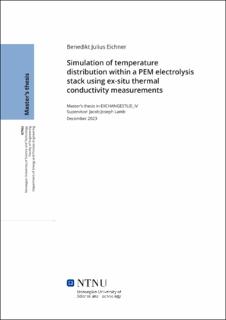| dc.description.abstract | Polymer Electrolyte Membrane (PEM) water electrolysers are considered to be particularly well suited to produce green hydrogen in industrial scale from fluctuating renewable sources. In order to increase production rates, the current densities are being gradually enhanced, which leads to increased heat production inside the Electrolysis Cells (ECs). It is therefore more and more important to consider thermal gradients within the single ECs inside the stacks. A 2D thermal numerical steady state model of an industrial-sized PEM electrolysis stack is therefore presented here. Thermal gradients within the ECs inside the stack are predicted both in stacking direction and along the channels of the Flow Fields (FFs). For this, through-plane thermal conductivities were measured ex-situ for titanium felt Porous Transport Layer (PTL), Tion5-W PFSA membrane and EC Catalyst Layers (CLs). At 16 bar compaction pressure, the wet PTL showed a thermal conductivity of (2.67 ± 0.21) Wm-1 K-1, the wet membrane of (0.31 ± 0.01) Wm-1 K-1 and the wet CL of (0.19 ± 0.03) Wm-1 K-1. Using these values in the stack model, thermal gradients of (16.5 ± 0.6) K in parallel flow and (17.6 ± 0.5) K in counter-flow were predicted within the cells of 1 m2 cell area at a current density of 2 A cm-2 and a mass flow rate of 0.15 kg s-1 water of 60 °C at the inlets of both anodic and cathodic FF. The counter-flow arrangement showed an advantage of 0.2% in voltage efficiency. With non-thermally-insulated end-plates, the maximal temperature was predicted to decrease in the outer cells of the stack by up to 3.7 K where the anodic half-cell adjoins the end-plate, and by up to 2.1 K where the cathodic half-cell adjoins the end-plates. Increasing the current density to 3 A cm-2 led to an increase in thermal gradients by about 10 K, both in parallel and counter-flow conditions. Using a sintered PTL, however, decreased the thermal gradients at 2 A cm-2 by around 3.7 K. The simulation showed an increase in maximal thermal gradients within the stack by 20 to 40 % compared to other models that use lumped properties within the cells. This underlines the importance of considering in-cell thermal gradients also on a stack level. | |
